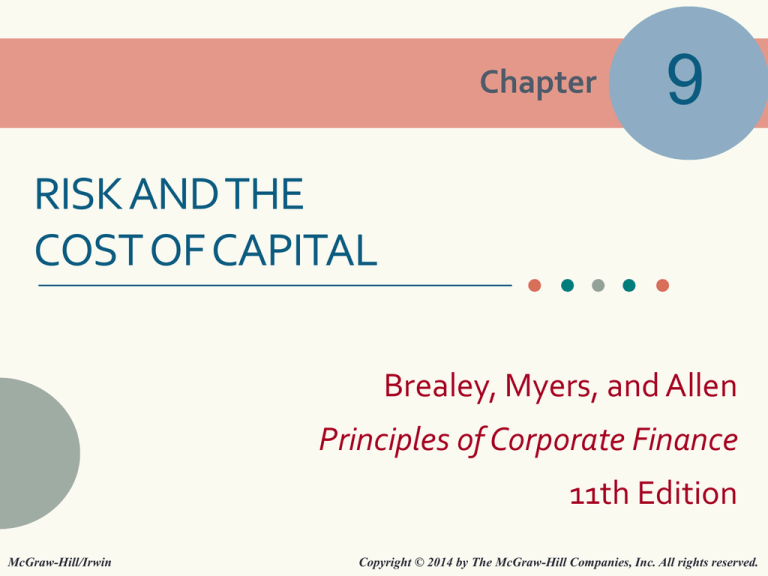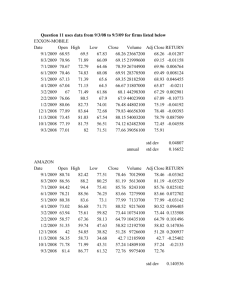
Chapter
9
RISK AND THE
COST OF CAPITAL
Brealey, Myers, and Allen
Principles of Corporate Finance
11th Edition
McGraw-Hill/Irwin
Copyright © 2014 by The McGraw-Hill Companies, Inc. All rights reserved.
9-1 COMPANY AND PROJECT COSTS OF CAPITAL
• Firm Value
• Sum of value of assets
Firm value PV(AB) PV(A) PV(B)
• Each asset is valued by discounting its
forecasted future cash flows at a rate
reflecting the risk of that asset.
9-2
FIGURE 9.1 COMPANY COST OF CAPITAL
• The company cost of capital is not the appropriate discount rate for all
its projects. If you consider each project as a mini-firm, the value of
that mini-firm depends on its beta.
SML
Required
return
5.5
Company cost
of capital
0.2
0
0.5
Project beta
• What happens if the firm uses the same cost of capital to value
different projects?
9-3
9-1 COMPANY AND PROJECT COSTS OF CAPITAL
• Company Cost of Capital
rassets COC rdebt VD requity VE
V DE
D Market val ue of debt
E Market val ue of equity
rdebt YTM on bonds
requity rf β(rm rf )
9-4
9-1 COMPANY AND PROJECT COSTS OF CAPITAL
• Weighted Average Cost of Capital
• Traditional measure of capital structure, risk
and return
WACC (1 Tc )r
r
D
D V
E
E V
9-5
9-2 MEASURING THE COST OF EQUITY
• Generally CAPM is used to estimate the
cost of equity:
•
r = rf + β(rm − rf)
• requity = rf + β(rm − rf)
9-6
9-2 MEASURING THE COST OF EQUITY
• Estimating Beta
• SML shows relationship between return and risk
• CAPM uses beta as proxy for risk
• Other methods can also determine slope of
SML and beta
• Regression analysis can be used to find beta
9-7
FIGURE 9.2A CITIGROUP RETURN
Weekly Data 2010-2011
beta =
alpha =
R-squared =
Correlation =
Annualized std dev of market =
Annualized std dev of stock =
Variance of stock =
Std error of beta
1.83
-0.31
0.64
0.80
19.52
44.55
1984.83
0.14
9-8
FIGURE 9.2B CITIGROUP RETURN
Wkly Data 2008-2009
beta =
3.32
alpha =
0.24
R-squared =
0.49
Correlation =
0.70
Annualized std dev of market =
Annualized std dev of stock =
Variance of stock =
Std error of beta
30.11
142.95
20436.08
0.34
9-9
FIGURE 9.2C DISNEY RETURN
Wkly Data 2010-2011
beta =
0.33
alpha =
0.02
R-squared =
0.22
Correlation =
0.47
Annualized std dev of market =
19.52
Annualized std dev of stock =
13.68
Variance of stock =
Std error of beta
187.13
0.06
9-10
FIGURE 9.2D DISNEY RETURN
Wkly Data 2008-2009
beta =
0.41
alpha =
0.17
R-squared =
0.19
Correlation =
0.44
Annualized std dev of market =
30.11
Annualized std dev of stock =
28.08
Variance of stock =
Std error of beta
788.62
0.08
9-11
FIGURE 9.2E CAMPBELL’S RETURN
Wkly Data 2010-2011
beta =
0.33
alpha =
0.02
R-squared =
0.22
Correlation =
0.47
Annualized std dev of market =
13.68
Annualized std dev of stock =
19.52
Variance of stock =
Std error of beta
381.22
0.06
9-12
FIGURE 9.2F CAMPBELL’S RETURN, %
Wkly Data 2008-2009
beta =
0.41
alpha =
0.17
R-squared =
0.19
Correlation =
0.44
Annualized std dev of market =
28.08
Annualized std dev of stock =
30.11
Variance of stock =
Std error of beta
906.55
0.08
9-13
TABLE 9.1 ESTIMATES OF BETAS
Beta
Standard Error
Canadian Pacific
1.27
.10
CSX
1.41
.08
Kansas City Southern
1.68
.12
Genesee & Wyoming
1.25
.08
Norfolk Southern
1.42
.09
Rail America
1.15
.14
Union Pacific
1.21
.07
Industry portfolio
1.34
.06
9-14
9-2 MEASURING THE COST OF EQUITY
• Beta Stability
RISK
CLASS
% IN SAME
CLASS
5 YEARS LATER
% WITHIN ONE
CLASS
5 YEARS LATER
10 (High betas)
35
69
9
18
54
8
16
45
7
13
41
6
14
39
5
14
42
4
13
40
3
16
45
2
21
61
1 (Low betas)
40
62
Source: Sharpe and Cooper (1972)
9-15
FIND THE DIVISION’S MARKET RISK AND COST OF CAPITAL BASED ON
THE CAPM AND THE PURE PLAY APPROACH, GIVEN THESE INPUTS:
• Target debt ratio = 10%.
• rd = 12%.
• rRF = 7%.
• Tax rate = 40%.
• Pure play company beta = 1.7.
• Market risk premium = 6%.
• Division’s required return on equity:
re
= rRF + (rM – rRF)B .
= 7% + (6%)1.7 = 17.2%.
WACCDiv. = wdrd(1 – T) + were
= 0.1(12%)(0.6) + 0.9(17.2%)
= 16.2%.
9-16
HOW DOES THE DIVISION’S WACC COMPARE
WITH THE FIRM’S OVERALL WACC?
• Division WACC = 16.2% versus company
WACC = 11.1%.
• “Typical” projects within this division would
be accepted if their returns are above
16.2%.
9-17
MEASURING THE COST OF EQUITY
EXTENSION: FINANCIAL LEVERAGE AND BETA
• The betas used in the CAPM are
estimated from returns on stocks. Thus,
they are the firm’s stock or equity beta.
• Imagine an individual who owns all the
firm’s debt and all its equity. In other
words, this individual owns the entire
firm. What is the beta of her portfolio of
the firm’s debt and equity?
9-18
9-2 MEASURING THE COST OF EQUITY
• Company cost of capital (COC) is based on
the average beta of the assets
• The average beta of the assets is based on
the % of funds in each asset
• Assets = debt + equity
D
E
β assets β debt β equity
V
V
Bequity = Basset (1+ D/E)
•
This equation is handy when we can not
calculate Be for the Project.
9-19
FINANCIAL LEVERAGE AND BETA
• Basset = D/(D+E) x Bd + E/(D+E) x Be
• Bd is very low in practice, we can assume Bd = 0
• Basset = E/(D+E) x Be
• For a levered firm, E/(D+E) < 1, hence
• Basset < Be
• Let us rewrite it:
• Be = Ba x (D+E)/ E
• Be = Ba (1 + D/E)
9-20
HOW TO DETERMINE THE RISK-ADJUSTED
COST OF CAPITAL FOR A PARTICULAR
DIVISION?
• Estimate the cost of capital that the division would
have if it were a stand-alone firm.
• This requires estimating the division’s beta, cost of
debt, and capital structure.
• One method for Estimating Beta for a Division is
the pure play approach.
• Find several publicly traded companies
exclusively in division’s business.
Use average of their betas as proxy for
division’s beta.
9-21
EX.: FINANCIAL LEVERAGE AND BETA
• Previously, we calculated a divisional WACC,
where Bdivision = 1,7.
• Assume that the pure play firms, on the
average, have D/V = 40% instead of D/V =
10% as targeted by the firm.
• How should we adjust the previous calculation
to reflect the difference in financial leverage?
• The process is called “unlever – relever”.
9-22
UNLEVER - RELEVER
• Unlever first:
• Be = Ba (1 + D/E)
• 1,7 = Ba (1 + 0,4/0,6)
• Ba = 1,018
• Relever:
• Be = 1,018 (1 + 0,1/0,9) = 1,13
• re = 7% + 1,13(6%) = 13,78
• WACCdiv = 0,1(12%)(0,6) + 0,9(13,8%)
• WACCdiv = 13,14% instead of 16,2%
9-23
9-4 CERTAINTY EQUIVALENTS—ANOTHER WAY
TO ADJUST FOR RISK
• Example
• Project A expects CF = $100 mil for each of
three years. What is PV of project given 6%
risk-free rate, 8% market premium, and .75
beta?
r rf β(rm rf )
6 .75(8)
12%
9-24
9-4 CERTAINTY EQUIVALENTS—ANOTHER WAY
TO ADJUST FOR RISK
• Example, continued
• Project A expects CF = $100 mil for each of
three years. What is PV of project given 6%
risk-free rate, 8% market premium, and .75
beta?
Project A
Year
Cash Flow
PV @ 12%
1
100
89.3
2
100
79.7
3
100
71.2
Total PV
240.2
9-25
9-4 CERTAINTY EQUIVALENTS—ANOTHER WAY
TO ADJUST FOR RISK
• Example, continued
• Now let us calculate the certainty equivalent cash flows.
• Certainty equivalent cash flows, when discounted at the
risk-free rate, should provide the same PV.
• Project B cash flows change, but are risk-free. What is new PV?
Project B
Project A
Year
Cash Flow
PV @ 12%
Year
Cash Flow
PV @ 6%
1
100
89.3
1
94.6
89.3
2
100
79.7
2
89.6
79.7
3
100
71.2
3
84.8
71.2
Total PV
240.2
Total PV
240.2
9-26
9-4 CERTAINTY EQUIVALENTS—ANOTHER WAY
TO ADJUST FOR RISK
• Example, continued
Project B
Project A
Year
Cash Flow
PV @ 12%
Year
Cash Flow
PV @ 6%
1
100
89.3
1
94.6
89.3
2
100
79.7
2
89.6
79.7
3
100
71.2
3
84.8
71.2
Total PV
240.2
Total PV
240.2
• 94.6 is risk-free, is certainty equivalent of 100
• Present value is obtained by discounting risky cash flows
using risk-adjusted discount rate. The certainty equivalent
cash flows are discounted at the risk-free rate to get the
9-27
9-4 CERTAINTY EQUIVALENTS—ANOTHER WAY
TO ADJUST FOR RISK
• Example, continued
• Project A expects CF = $100 mil for each of three years.
What is PV of project given 6% risk-free rate, 8%
market premium, and .75 beta?
Year Cash Flow
CEQ Risk Deduction
1
100
94.6
5.4
2
100
89.6
10.4
3
100
84.8
15.2
9-28
9-4 CERTAINTY EQUIVALENTS—ANOTHER WAY
TO ADJUST FOR RISK
• Example, continued
• Project A expects CF = $100 mil for each of three years.
What is PV of project given 6% risk-free rate, 8%
market premium, and .75 beta?
• Assume cash flows change, but are risk-free. What is
new PV?
• Difference between 100 and certainty equivalent
(94.6) is 5.66%
• This % can be considered annual premium on risky
cash flow
Risky cash flow
certainty equivalent cash flow
1.0566
9-29
9-4 CERTAINTY EQUIVALENTS—ANOTHER WAY
TO ADJUST FOR RISK
• Example, continued
• Project A expects CF = $100 mil for each of three years.
What is PV of project given 6% risk-free rate, 8%
market premium, and .75 beta?
• Assume cash flows change, but are risk-free. What is
new PV?
100
Year 1
94.6
1.0566
100
Year 2
89.6
2
1.0566
100
Year 3
84.8
3
1.0566
9-30




